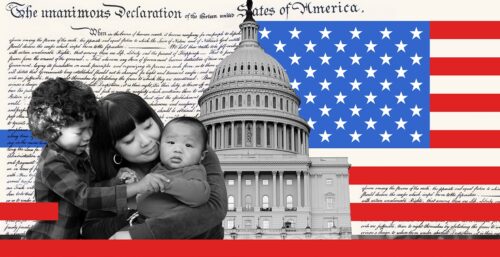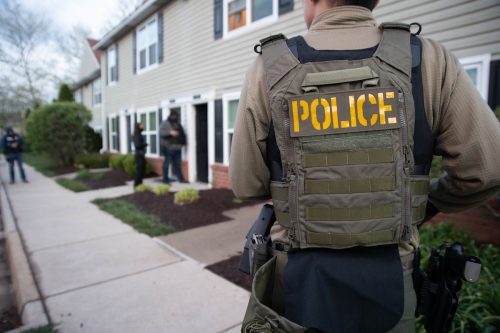From 1987 to 1990, Presidents Ronald Reagan and George Bush, Sr. used their executive authority to protect from deportation a group that Congress left out of its 1986 immigration reform legislation—the spouses and children of individuals who were in the process of legalizing. These “Family Fairness” actions were taken to avoid separating families in which one spouse or parent was eligible for legalization, but the other spouse or children living in the United States were not—and thus could be deported, even though they would one day be eligible for legal status when the spouse or parent legalized. Publicly available estimates at the time were that “Family Fairness” could cover as many as 1.5 million family members, which was approximately 40 percent of the then-unauthorized population. After Reagan and Bush acted, Congress later protected the family members. This fact sheet provides a chronological history of the executive actions and legislative debate surrounding Family Fairness.
|
November 6, 1986: |
President Reagan signs the Simpson-Mazzoli Immigration Reform and Control Act (IRCA). The legislation makes certain immigrants eligible for temporary legal status and eventually green cards, primarily (1) those “continuously” present in the U.S. since January 1, 1982 (the general legalization provisions), and (2) special agricultural workers (SAW). At the time, roughly 3 million people are thought to be eligible to legalize, although that number will rise by 1990, due to an unexpectedly large number of SAW applicants, and litigation by several hundred thousand persons who claimed eligibility for the general legalization provisions. IRCA does not contain language regarding spouses and children who don’t independently qualify for legalization. As a Senate Judiciary Committee report accompanying the legislation stated, “the families of legalized aliens will obtain no special petitioning right by virtue of the legalization. They will be required to ‘wait in line’.” When the Senate-passed bill moved to the House, IRCA’s legalization provisions survived an amendment to strike them by seven votes. |
|
1987: |
The plight of “split-eligibility” families immediately becomes a key issue post-IRCA. For example, the National Conference of Catholic Bishops criticizes the separation of families, and urges Reagan’s intervention.” The Los Angeles Catholic archdiocese reports that up to 30 percent of the legalization applications it was assisting involved “split-eligibility” families. |
|
October 7, 1987: |
In an effort to address “split-eligibility” families, Sen. John Chafee (R-RI) offers an amendment to an unrelated bill that would give spouses and children excluded from IRCA a path to legalization. The Senate defeats the amendment by a 55-45 vote. Among others, IRCA’s lead Senate sponsor, Sen. Alan K. Simpson (R-WY), opposes Chafee’s amendment as a “second amnesty” that “destroys the delicate balance of the recently passed immigration reform legislation.” Citing the Senate Judiciary Committee’s report, Simpson stated “[t]here is no question about what the legislative intent is or was.” |
|
October 21, 1987: |
Two weeks later, Reagan’s INS Commissioner Alan C. Nelson announces INS’ “Family Fairness” executive action. The INS’ memo explains the “clear” Congressional intent in 1986 to exclude family members from the legalization program. Nevertheless, the INS defers deportation for children living in a two-parent household with both parents legalizing, or living with a single parent who was legalizing. As to spouses, though, the INS directs that similar relief “generally not be granted”—only if “compelling or humanitarian factors” exist on top of marriage alone. |
|
October 27, 1987: |
The Washington Post editorial board, among other news outlets, applauds INS’ policy. Citing IRCA’s Congressional history and the recent Senate defeat of Chafee’s amendment, the Post argues that “If Congress will not be moved, the INS should have a heart.” |
|
October 27, 1987: |
Sen. Chafee and eight other Senators criticize INS’ policy for not going far enough to cover spouses and ineligible children. |
|
October 29, 1987: |
The House Appropriations Committee reports a continuing resolution (CR) on appropriations to the House floor. The CR includes an amendment by Rep. Edward Roybal (D-CA)—narrower than Chafee’s, but broader than INS’ Family Fairness policy—to block funding for deportation of both spouses and children of legalizing families. |
|
December 3, 1987: |
IRCA’s lead House sponsor, Rep. Romano Mazzoli (D-KY), among others, criticizes Roybal’s amendment during the House floor’s CR debate because it “reverses the whole idea of the Immigration Reform and Control Act of 1986.” Rep. Hal Rogers (R-KY) also states, “[I]f my colleagues were concerned last year… about the amnesty portion of that bill, and it only carried by six votes… this continuing resolution violates completely the amnesty provisions delicately worked out last year.” Rep. Bill McCollum (R-FL) argues the amendment “means another 50 percent or better expansion of the number of illegals who are immediately going to come into this country.” Nevertheless, the CR passes the House with Roybal’s amendment included. |
|
December 22, 1987: |
The Senate appropriations bill does not include Roybal’s amendment, and the amendment does not survive House-Senate conference negotiations. |
|
August 23, 1988: |
House Judiciary Committee testimony details the still-large problem of “split-eligibility” families. Vanna Slaughter of Catholic Charities in Texas testifies that about one-third of Catholic Charities’ applicants had ineligible family members. Another witness testifies that Slaughter’s numbers are “going to be the tip of the iceberg,” since many applying have no lawyer and might not know family could qualify for Family Fairness. |
|
January 20, 1989: |
President George H.W. Bush takes office. |
|
June 16, 1989: |
INS Commissioner Alan C. Nelson leaves office. |
|
July 13, 1989: |
The Senate passes immigration legislation. The legislation includes an amendment by Sen. Chafee to protect both ineligible spouses and children from deportation—scaled back from his prior amendment that provided a path to legalization. Despite Chafee scaling back the amendment, Sen. Simpson repeats his objections based on the Congressional intent behind IRCA. He states that Chafee’s amendment “is not quite the same but yet it is,” and calls it “a de facto second amnesty.” However, Sen. Pete Wilson (R-CA) switches his vote and speaks for Chafee’s amendment. Echoing the current debate, Wilson argues that “this country was built on certain values” like the “value of the family unit,” and in any event, “we simply do not have the manpower” to enforce the law as written. Chafee’s amendment passes 61-38. Sen. Chafee’s office publicly estimates that about 1.5 million family members would be affected, based on several recent immigration reports made available to senators. |
|
August 1989: |
The INS releases its Statistical Yearbook 1988, which provides demographic information on the legalizing individuals whose family members are under debate. The Yearbook reports that INS had received nearly 3.1 million legalization applications. Of those that had applied for legalization by 1988, about 41.5 percent of those seeking general legalization were married, with another 9.8 percent separated, divorced, widowed or unknown. Of those applying for SAW legalization, 42.5 percent were married. The INS did not report data on children of individuals who were legalizing. Combined, these categories indicate that a large pool of potential Family Fairness applicants exists (i.e. spouses and children of legalizing individuals, whom themselves are ineligible for IRCA). |
|
August 1989: |
Additionally, a California study which surveyed a sample of the legalizing population finds that 68 percent of those applying for general legalization, and 43 percent of SAW applicants, were married. Only 30 percent of those applying for general legalization, and 63 percent of SAW applicants, reported no children living with them. |
|
October 26, 1989: |
New INS Commissioner Gene McNary is sworn into office. |
|
November 9, 1989: |
The House Judiciary Committee’s immigration subcommittee holds a hearing on Rep. Bruce Morrison’s (D-CT) H.R. 3374, which includes a provision echoing Chafee’s amendment to protect both ineligible spouses and children from deportation. The INS (among others) strongly opposes the provision as creating a “second legalization program contrary to the intent of Congress,” and “outside the carefully crafted balance” of IRCA. Other groups support the provision, arguing that individuals are afraid to apply for Family Fairness because the INS would put applicants into deportation proceedings. The INS’ counsel testifies it is “correct” that potentially eligible spouses and children constituted a “lot of people,” although he didn’t “have the numbers.” Now-former INS Commissioner Nelson states “the potential number is obviously enormous.” The Director of the Center for Immigration Studies also cites “immense demographic consequences,” and that Chafee’s provision “would grant de facto residence status to some 1.5 million.” H.R. 3374 does not move forward. |
|
February 2, 1990: |
President Bush’s INS now expands Reagan’s Family Fairness policy to all ineligible spouses and children under 18 of legalizing family members, provided they meet certain criteria. The INS also provides them eligibility to apply for work authorization. INS Commissioner McNary noted that Bush’s executive policy matched the Senate provisions, even though the House had not yet acted. The Commissioner also states, “We can enforce the law humanely… To split families encourages further violations of the law as they reunite.” The San Francisco Chronicle reports that INS officials said the policy “is likely to benefit more than 100,000 people,” while the Washington Post reports that it could “prevent the deportation of as many as 100,000 illegal aliens.” That said, an INS spokesman also said that the number of immigrants affected “may run to a million,” and did not dispute large estimates from immigrant advocacy groups. The unpredictability appears to depend on whether immigrants overcome their fear and apply. |
|
February 6, 1990: |
The Washington Post editorial board, among others, applauds INS’ expanded Family Fairness policy, calling it “sensible, humane and fair.” The Post notes it is “not an extension of amnesty, which would have required legislation,” but calls it “in line with traditional policy to favor immigration that reunites families.” |
|
February 6, 1990: |
Senator Chafee applauds Bush’s Family Fairness action, which largely mirrored the Senator’s own legislative proposal. He says, “Mr. President… the family unit is sacred,” and “I am delighted, after four years of hard work, to see this principle triumph through the new Family Fairness guidelines.” |
|
February 8, 1990: |
An INS internal Decision Memorandum to Commissioner McNary states that Family Fairness “provides voluntary departure and employment authorization to potentially millions of individuals,” and discusses processing options given the “large workload.” An INS “Draft Processing Plan,” also dated this day, states that “current estimates are that greater than one million IRCA-ineligible family members will file for” Family Fairness. The plan calculates the financial resources required to process 1 million applications in 100 workdays. |
|
February 12, 1990: |
The INS releases Family Fairness processing guidelines. The filing fee for a work authorization application is $35. |
|
February 21, 1990: |
INS Commissioner McNary testifies before the House Judiciary Committee. McNary states to Rep. Morrison that there are about 1.5 million ineligible family members covered by Family Fairness here in the United States. McNary also states that there are another 1.5 million ineligible family members of the legalizing population, presumably outside the United States. |
|
February 26, 1990: |
A bulletin reports that the INS statistics office estimates that of the 3.1 million IRCA applicants at that point, 42 percent (1.3 million) were married. The INS conceded that it lacked “reliable data” regarding children. (Using current estimation tools, as many as 600,000 children of IRCA applicants may have been residing in the U.S in 1990). The INS also notes that over 740,000 legalization applications are pending or on appeal, and other class-action litigants are suing to legalize as well. Their relatives cannot yet apply for Family Fairness protection. However, once their legalization applications are approved, their family members will be eligible to apply. |
|
March 5, 1990: |
The New York Times reports McNary’s February 21 testimony that “as many as 1.5 million illegal aliens could be affected by the new policy.” |
|
March 19, 1990: |
Rep. Morrison introduces legislation which again includes a provision to defer deportations of the Family Fairness relatives. |
|
September 1990: |
The INS updates its statistics on the legalizing population in its Statistical Yearbook 1989. The INS reports that over 3 million have applied for legalization through general provisions or SAW. Of those whom applied for general legalization, 41.2 percent are married, and 9.9 percent are separated, divorced, widowed, or unknown. Of those whom applied for SAW, 41.7 percent are married, and 4.6 percent are separated, divorced, widowed, or unknown. The INS does not report data on children. |
|
October 27, 1990: |
The House and Senate conference agrees to a combined Immigration Act of 1990, which includes the provisions to defer deportation of the Family Fairness relatives (now called “Family Unity” provisions). |
|
November 29, 1990: |
President Bush signs the combined Immigration Act of 1990. He salutes its “support for the family as the essential unit of society,” and “respect for the family unit.” He also issues a signing statement, preserving the “authority of the executive branch to exercise prosecutorial discretion in suitable immigration cases.” Congress’ “Family Unity” provisions supersede the executive “Family Fairness” policy, as of Oct. 1, 1991. Those Family Unity provisions are still in place today. The Immigration Act of 1990 also dramatically increases the number of visas available to spouses and minor children of those with lawful permanent resident status (i.e. a green card). |
|
1990-1995: |
Although it is unclear how many spouses and children of the legalizing population ultimately apply for the “family fairness” or “family unity” provisions, large numbers likely apply directly for green cards that were made available under the Immigration Act of 1990. For example, the 1995 report of the State Department’s Office of Visa Services estimated that spouses or children of those legalized under IRCA represented 80 percent of the 1.1 million applications by immediate relatives of lawful permanent residents, at that time (about 880,000 people). Family Fairness continued through Oct. 1, 1991. As of October 1, 1990, INS had received 46,821 applications. Explanations for low application rates included fear and stringent documentary requirements. As to Family Unity protection, it is unclear how many applied. About 140,000 individuals likely applied for a related “legalization dependent” visa, made available to the class of individuals eligible for Family Unity protection, and outside the normal visa caps. One reason for relatively low rates of application for Family Fairness/Unity protection may be that many decided to apply directly for a green card, rather than making two applications. |



